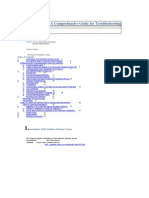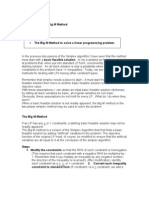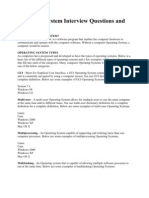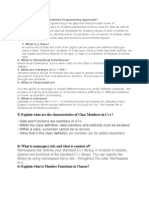Operating System Questions
Uploaded by
Anonymous V7P5fNQIOperating System Questions
Uploaded by
Anonymous V7P5fNQIOperating system questions
By admin | January 17, 2005 1. What are the basic functions of an operating system? - Operating system controls and coordinates the use of the hard are among the !arious applications programs for !arious uses. Operating system acts as resource allocator and manager. "ince there are many possi#ly conflicting re$uests for resources the operating system must decide hich re$uests are allocated resources to operating the computer system efficiently and fairly. %lso operating system is control program hich controls the user programs to pre!ent errors and improper use of the computer. &t is especially concerned ith the operation and control of &'O de!ices. 2. Why paging is used? - (aging is solution to e)ternal fragmentation pro#lem hich is to permit the logical address space of a process to #e noncontiguous, thus allo ing a process to #e allocating physical memory here!er the latter is a!aila#le. *. While running DOS on a PC, which command would be used to duplicate the entire diskette? dis+copy ,. What resources are used when a thread created? ow do they differ from those when a process is created? - -hen a thread is created the threads does not re$uire any ne resources to e)ecute the thread shares the resources li+e memory of the process to hich they #elong to. .he #enefit of code sharing is that it allo s an application to ha!e se!eral different threads of acti!ity all ithin the same address space. -hereas if a ne process creation is !ery hea!y eight #ecause it al ays re$uires ne address space to #e created and e!en if they share the memory then the inter process communication is e)pensi!e hen compared to the communication #et een the threads. 5. What is !irtual memory? - /irtual memory is hard are techni$ue here the system appears to ha!e more memory that it actually does. .his is done #y timesharing, the physical memory and storage parts of the memory one dis+ hen they are not acti!ely #eing used. 0. What is "hroughput, "urnaround time, waiting time and #esponse time? .hroughput 12345367 num#er of processes that complete their e)ecution per time unit. .urnaround time 12345367 amount of time to e)ecute a particular process. -aiting time 12345367 amount of time a process has #een aiting in the
ready $ueue. 8esponse time 12345367 amount of time it ta+es from hen a re$uest as su#mitted until the first response is produced, not output 9for timesharing en!ironment:. 7. What is the state of the processor, when a process is waiting for some e!ent to occur? - -aiting state ;. What is the important aspect of a real$time system or %ission Critical Systems? - % real time operating system has ell defined fi)ed time constraints. (rocess must #e done ithin the defined constraints or the system ill fail. %n e)ample is the operating system for a flight control computer or an ad!anced <et airplane. Often used as a control de!ice in a dedicated application such as controlling scientific e)periments, medical imaging systems, industrial control systems, and some display systems. 8eal-.ime systems may #e either hard or soft real-time. ard real$time= "econdary storage limited or a#sent, data stored in short term memory, or read-only memory 98O>:, ?onflicts ith time-sharing systems, not supported #y general-purpose operating systems. Soft real$time= @imited utility in industrial control of ro#otics, Aseful in applications 9multimedia, !irtual reality: re$uiring ad!anced operating-system features. B. What is the difference between ard and Soft real$time systems? - % hard real-time system guarantees that critical tas+s complete on time. .his goal re$uires that all delays in the system #e #ounded from the retrie!al of the stored data to the time that it ta+es the operating system to finish any re$uest made of it. % soft real time system here a critical real-time tas+ gets priority o!er other tas+s and retains that priority until it completes. %s in hard real time systems +ernel delays need to #e #ounded 10. What is the cause of thrashing? ow does the system detect thrashing? Once it detects thrashing, what can the system do to eliminate this problem? .hrashing is caused #y under allocation of the minimum num#er of pages re$uired #y a process, forcing it to continuously page fault. .he system can detect thrashing #y e!aluating the le!el of ?(A utiliCation as compared to the le!el of multiprogramming. &t can #e eliminated #y reducing the le!el of multiprogramming. 11. What is multi tasking, multi programming, multi threading? - %ulti programming= >ultiprogramming is the techni$ue of running se!eral programs at a time using timesharing. &t allo s a computer to do se!eral things at the same time. >ultiprogramming creates logical parallelism. .he concept of multiprogramming is that the operating system +eeps se!eral <o#s in memory simultaneously. .he operating system selects a <o# from the <o# pool and starts e)ecuting a <o#, hen that <o# needs to ait for any i'o operations the ?(A is s itched to another <o#. "o the main idea here is that the ?(A is ne!er idle. %ulti tasking= >ultitas+ing is the logical e)tension of multiprogramming ..he concept of multitas+ing is $uite similar to multiprogramming #ut difference is that the s itching #et een <o#s occurs so fre$uently that the users can interact ith each program hile it is running. .his concept is also +no n as time-sharing systems. % time-shared operating system uses ?(A scheduling and multiprogramming to pro!ide each user ith a small portion of time-shared system. %ulti threading= %n application typically is implemented as a separate process ith se!eral threads
of control. &n some situations a single application may #e re$uired to perform se!eral similar tas+s for e)ample a e# ser!er accepts client re$uests for e# pages, images, sound, and so forth. % #usy e# ser!er may ha!e se!eral of clients concurrently accessing it. &f the e# ser!er ran as a traditional single-threaded process, it ould #e a#le to ser!ice only one client at a time. .he amount of time that a client might ha!e to ait for its re$uest to #e ser!iced could #e enormous. "o it is efficient to ha!e one process that contains multiple threads to ser!e the same purpose. .his approach ould multithread the e#-ser!er process, the ser!er ould create a separate thread that ould listen for client re$uests hen a re$uest as made rather than creating another process it ould create another thread to ser!ice the re$uest. .o get the ad!antages li+e responsi!eness, 8esource sharing economy and utiliCation of multiprocessor architectures multithreading concept can #e used. 12. What is hard disk and what is its purpose? - Dard dis+ is the secondary storage de!ice, hich holds the data in #ul+, and it holds the data on the magnetic medium of the dis+.Dard dis+s ha!e a hard platter that holds the magnetic medium, the magnetic medium can #e easily erased and re ritten, and a typical des+top machine ill ha!e a hard dis+ ith a capacity of #et een 10 and ,0 giga#ytes. Eata is stored onto the dis+ in the form of files. 1*. What is fragmentation? Different types of fragmentation? - Fragmentation occurs in a dynamic memory allocation system hen many of the free #loc+s are too small to satisfy any re$uest. &'ternal (ragmentation= G)ternal Fragmentation happens hen a dynamic memory allocation algorithm allocates some memory and a small piece is left o!er that cannot #e effecti!ely used. &f too much e)ternal fragmentation occurs, the amount of usa#le memory is drastically reduced. .otal memory space e)ists to satisfy a re$uest, #ut it is not contiguous. )nternal (ragmentation= &nternal fragmentation is the space asted inside of allocated memory #loc+s #ecause of restriction on the allo ed siCes of allocated #loc+s. %llocated memory may #e slightly larger than re$uested memoryH this siCe difference is memory internal to a partition, #ut not #eing used 1,. What is D#*%? )n which form does it store data? - E8%> is not the #est, #ut itIs cheap, does the <o#, and is a!aila#le almost e!ery here you loo+. E8%> data resides in a cell made of a capacitor and a transistor. .he capacitor tends to lose data unless itIs recharged e!ery couple of milliseconds, and this recharging tends to slo do n the performance of E8%> compared to speedier 8%> types. 15. What is Dispatcher? - Eispatcher module gi!es control of the ?(A to the process selected #y the short-term schedulerH this in!ol!es= " itching conte)t, " itching to user mode, Jumping to the proper location in the user program to restart that program, dispatch latency 12345367 time it ta+es for the dispatcher to stop one process and start another running. 10. What is CP+ Scheduler? - "elects from among the processes in memory that are ready to e)ecute, and allocates the ?(A to one of them. ?(A scheduling decisions may ta+e place hen a process= 1." itches from running to aiting state. 2." itches from running to ready state. *." itches from aiting to ready. ,..erminates. "cheduling under 1 and , is non-preempti!e. %ll other scheduling is preempti!e.
17. What is Conte't Switch? - " itching the ?(A to another process re$uires sa!ing the state of the old process and loading the sa!ed state for the ne process. .his tas+ is +no n as a conte)t s itch. ?onte)t-s itch time is pure o!erhead, #ecause the system does no useful or+ hile s itching. &ts speed !aries from machine to machine, depending on the memory speed, the num#er of registers hich must #e copied, the e)isted of special instructions9such as a single instruction to load or store all registers:. 1;. What is cache memory? - ?ache memory is random access memory 98%>: that a computer microprocessor can access more $uic+ly than it can access regular 8%>. %s the microprocessor processes data, it loo+s first in the cache memory and if it finds the data there 9from a pre!ious reading of data:, it does not ha!e to do the more time-consuming reading of data from larger memory. 1B. What is a Safe State and what is its use in deadlock a!oidance? - -hen a process re$uests an a!aila#le resource, system must decide if immediate allocation lea!es the system in a safe state. "ystem is in safe state if there e)ists a safe se$uence of all processes. Eeadloc+ %!oidance= ensure that a system ill ne!er enter an unsafe state. 20. What is a #eal$"ime System? - % real time process is a process that must respond to the e!ents ithin a certain time period. % real time operating system is an operating system that can run real time processes successfully
You might also like
- What Is Paging? Why Paging Is Used?: Resource Allocator and ManagerNo ratings yetWhat Is Paging? Why Paging Is Used?: Resource Allocator and Manager8 pages
- Operating System Interview Questions and Answers100% (1)Operating System Interview Questions and Answers8 pages
- What Are The Three Main Purposes of An Operating75% (4)What Are The Three Main Purposes of An Operating6 pages
- Operating System Questions: by Admin - January 17, 2005No ratings yetOperating System Questions: by Admin - January 17, 200512 pages
- What Is Paging? Why Paging Is Used?: Resource Allocator and ManagerNo ratings yetWhat Is Paging? Why Paging Is Used?: Resource Allocator and Manager8 pages
- Unit I Overview & Instructions: Cs6303-Computer Architecture100% (1)Unit I Overview & Instructions: Cs6303-Computer Architecture16 pages
- Operating System Interview Questions and AnswersNo ratings yetOperating System Interview Questions and Answers5 pages
- Operating System Viva Questions: 1. Explain The Concept of Reentrancy?No ratings yetOperating System Viva Questions: 1. Explain The Concept of Reentrancy?7 pages
- Topic Notes: Memory Management: Computer Science 322 Operating SystemsNo ratings yetTopic Notes: Memory Management: Computer Science 322 Operating Systems25 pages
- Operating Systems Lecture Notes Processes and ThreadsNo ratings yetOperating Systems Lecture Notes Processes and Threads4 pages
- Introduction of Operating System Q - What Is An Operating System?No ratings yetIntroduction of Operating System Q - What Is An Operating System?41 pages
- Multiprocessor Systems: 1. Increased Throughput. by Increasing The Number of Processors, We ExpectNo ratings yetMultiprocessor Systems: 1. Increased Throughput. by Increasing The Number of Processors, We Expect8 pages
- Guide to Multithreading and MultiprocessingNo ratings yetGuide to Multithreading and Multiprocessing6 pages
- Operating Systems Lecture Notes Processes and Threads: Martin C. RinardNo ratings yetOperating Systems Lecture Notes Processes and Threads: Martin C. Rinard12 pages
- OS MI Assignment - 1: 1. Fixed Partition (Static) SchemeNo ratings yetOS MI Assignment - 1: 1. Fixed Partition (Static) Scheme3 pages
- AOS - Theory - Multi-Processor & Distributed UNIX Operating Systems - INo ratings yetAOS - Theory - Multi-Processor & Distributed UNIX Operating Systems - I13 pages
- Operating System Concepts: GovindarajanNo ratings yetOperating System Concepts: Govindarajan55 pages
- Operating Systems Interview Questions You'll Most Likely Be AskedFrom EverandOperating Systems Interview Questions You'll Most Likely Be AskedNo ratings yet
- Ge6151 Computer Programming LTPC 3 0 0 3 Unit I Introduction 8No ratings yetGe6151 Computer Programming LTPC 3 0 0 3 Unit I Introduction 81 page
- 3TU Course On MIMO Wireless Communication: Jean-Paul Linnartz September 2006No ratings yet3TU Course On MIMO Wireless Communication: Jean-Paul Linnartz September 200617 pages
- Structures, Unions, and Typedefs: CS-2303 System Programming ConceptsNo ratings yetStructures, Unions, and Typedefs: CS-2303 System Programming Concepts32 pages
- Unit Iv Graphs: 1. Directed Graph or DigraphNo ratings yetUnit Iv Graphs: 1. Directed Graph or Digraph10 pages
- Introduction To C#: Tom Roeder CS 215 2006faNo ratings yetIntroduction To C#: Tom Roeder CS 215 2006fa25 pages
- Generations of Computers: Anitha Padmanaban AcetNo ratings yetGenerations of Computers: Anitha Padmanaban Acet31 pages
- Arduino 101 - Basics of Programming in ArduinoNo ratings yetArduino 101 - Basics of Programming in Arduino8 pages
- Ece Vii Embedded System Design (10ec74) Notes75% (8)Ece Vii Embedded System Design (10ec74) Notes110 pages
- Stranchat: Department of Computer Science, Christ UniversityNo ratings yetStranchat: Department of Computer Science, Christ University54 pages
- Owners Manual For PowerAlert Software Versons 48-49-51 932990 enNo ratings yetOwners Manual For PowerAlert Software Versons 48-49-51 932990 en28 pages
- Software Quality Assurance Plan - MSE - Phase INo ratings yetSoftware Quality Assurance Plan - MSE - Phase I8 pages
- What Is Object Oriented Programming ApproachNo ratings yetWhat Is Object Oriented Programming Approach30 pages
- What Is Paging? Why Paging Is Used?: Resource Allocator and ManagerWhat Is Paging? Why Paging Is Used?: Resource Allocator and Manager
- Operating System Questions: by Admin - January 17, 2005Operating System Questions: by Admin - January 17, 2005
- What Is Paging? Why Paging Is Used?: Resource Allocator and ManagerWhat Is Paging? Why Paging Is Used?: Resource Allocator and Manager
- Unit I Overview & Instructions: Cs6303-Computer ArchitectureUnit I Overview & Instructions: Cs6303-Computer Architecture
- Operating System Viva Questions: 1. Explain The Concept of Reentrancy?Operating System Viva Questions: 1. Explain The Concept of Reentrancy?
- Topic Notes: Memory Management: Computer Science 322 Operating SystemsTopic Notes: Memory Management: Computer Science 322 Operating Systems
- Operating Systems Lecture Notes Processes and ThreadsOperating Systems Lecture Notes Processes and Threads
- Introduction of Operating System Q - What Is An Operating System?Introduction of Operating System Q - What Is An Operating System?
- Multiprocessor Systems: 1. Increased Throughput. by Increasing The Number of Processors, We ExpectMultiprocessor Systems: 1. Increased Throughput. by Increasing The Number of Processors, We Expect
- Operating Systems Lecture Notes Processes and Threads: Martin C. RinardOperating Systems Lecture Notes Processes and Threads: Martin C. Rinard
- OS MI Assignment - 1: 1. Fixed Partition (Static) SchemeOS MI Assignment - 1: 1. Fixed Partition (Static) Scheme
- AOS - Theory - Multi-Processor & Distributed UNIX Operating Systems - IAOS - Theory - Multi-Processor & Distributed UNIX Operating Systems - I
- Operating System Interview Questions and AnswersFrom EverandOperating System Interview Questions and Answers
- Operating Systems Interview Questions You'll Most Likely Be AskedFrom EverandOperating Systems Interview Questions You'll Most Likely Be Asked
- Ge6151 Computer Programming LTPC 3 0 0 3 Unit I Introduction 8Ge6151 Computer Programming LTPC 3 0 0 3 Unit I Introduction 8
- 3TU Course On MIMO Wireless Communication: Jean-Paul Linnartz September 20063TU Course On MIMO Wireless Communication: Jean-Paul Linnartz September 2006
- Structures, Unions, and Typedefs: CS-2303 System Programming ConceptsStructures, Unions, and Typedefs: CS-2303 System Programming Concepts
- Stranchat: Department of Computer Science, Christ UniversityStranchat: Department of Computer Science, Christ University
- Owners Manual For PowerAlert Software Versons 48-49-51 932990 enOwners Manual For PowerAlert Software Versons 48-49-51 932990 en








































































































